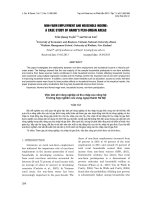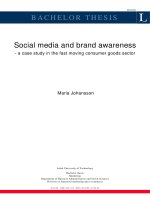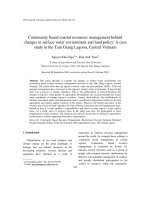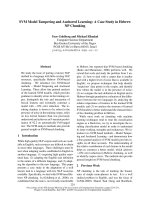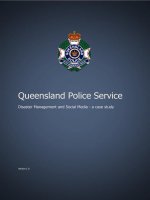Queensland Police Service: Disaster Management and Social Media - a case study docx
Bạn đang xem bản rút gọn của tài liệu. Xem và tải ngay bản đầy đủ của tài liệu tại đây (601.85 KB, 11 trang )
Queensland Police Service
Disaster Management and Social Media - a case study
Version 1.0
Disaster Management and Social Media - a case study
i
Produced by the Media and Public Affairs Branch, Queensland Police Service
For more information contact:
or 07 3364 6476
This work is licenced under a Creative Commons Attribution 2.5 Australia Licence.
HTTP://CREATIVECOMMONS.ORG/LICENSES/BY/2.5/AU
Disaster Management and Social Media - a case study
ii
CONTENTS
Executive Summary i
Background ii
Disaster declared iii
Sudden escalation iv
What were Police Media doing during the disaster? iv
Basic services provided by Police Media during this time were: v
Why did it work? v
Praise from Government vi
The benefits of social media in a disaster vi
Praise from Facebook vii
Lessons learnt vii
Contacts vii
Praise from Media viii
Disaster Management and Social Media - a case study
i
EXECUTIVE SUMMARY
I am pleased to present to you this case study which documents our significant and what has been described as
world leading efforts in using social media for public engagement and emergency disaster responsiveness.
It has been at times a challenging path, but through good will and team work on the part of the community of
Queensland, we have established what I believe to be a best practise example of the use of social media by a
government department for both engaging with the public and informing frontline colleagues in times of a
disaster. In recognising this, I felt it appropriate to document our experience so others could learn from and
apply some of the lessons we learned.
Our social media strategy centered on public communications and community engagement issues. This was
arguably during the most difficult period of natural disasters in the history of Queensland with more than 90
precent of the state disaster-declared. Through the use of social media, we were able to communicate directly to
the people of Queensland which was invaluable, helping us become more effective in supporting and serving the
needs of the community.
At the Queensland Police Service, we will continue to innovate with social media and other online tools. I hope
you find value in this case study and I welcome your comments and feedback.
KYM CHARLTON
EXECUTIVE DIRECTOR, MEDIA AND PUBLIC AFFAIRS BRANCH
Disaster Management and Social Media - a case study
ii
BACKGROUND
The Queensland Police Service (QPS) Media and Public Affairs Branch began a trial use of social media accounts
Facebook, Twitter and YouTube in May 2010.
The aim was to:
• claim our social media presence
• engage in a two-way conversation between the QPS and the public
• develop an online community of followers before a disaster occurred, in light of international examples
such as the Mumbai terrorist attacks where social media dominated mainstream media coverage but
authorities were not able to contribute or manage it with their own social media presence.
Police Media allowed interest in its social media accounts to initially grow by word of mouth keeping growth to a
steady and manageable level. This organic growth rate allowed the media team to steadily develop their social
media skills and procedures. It also gave the team the time to educate and guide its online community about
appropriate behaviour on its social media sites. While initial responsibility for the maintenance of these accounts
fell to a few select individuals within the team, management was able to gradually introduce social media to
everyday processes so that all members grew to be comfortable with uploading information and moderating the
accounts.
A legislative change on 1 November 2010 resulted in the QPS becoming the lead agency in the response phase
of a disaster. By this date, approximately six months after the social media trial began, the QPS had 8000 “likes”
on Facebook and 1000 followers on Twitter.
FIG. 01 – GROWTH OF QPS FACEBOOK “LIKES” FROM MAY 2010 TO DECEMBER 2010
Disaster Management and Social Media - a case study
iii
DISASTER DECLARED
Significant rain began to fall over a large part of Queensland in mid-December 2010, and on 24 December
Deputy Commissioner Ian Stewart was declared the first State Disaster Coordinator under the new legislation.
Category 1 Tropical Cyclone Tasha struck on Christmas Day, bringing heavy rain to central Queensland, resulting
in significant floods.
During this time, Police Media used its established processes to deliver public safety information about the
extreme weather events to the media and public. In addition to issuing regular media releases to the mainstream
media and uploading these releases to the QPS website, it was also part of the general process to add these
media releases to the QPS Facebook page and link to these on Twitter. This disaster contributed to the first
significant spike in the number of people following the QPS social media accounts, with numbers more than
doubling in two weeks.
FIG. 02 - GROWTH OF QPS FACEBOOK “LIKES” FROM MAY 2010 TO JANUARY 2011
Disaster Management and Social Media - a case study
iv
SUDDEN ESCALATION
On January 10, 2011 a flash flood described as an instant inland tsunami struck Toowoomba and the Lockyer
Valley. Just days later, significant floods hit Ipswich and Brisbane. By the second week of January, 200,000
Queenslanders were flood affected and three-quarters of the state was disaster declared.
In the 24-hour period following the flash floods, the number of “likes” on the QPS Facebook page increased from
approximately 17,000 to 100,000. This same day the QPS Facebook page generated 39 million post impressions,
equating to 450 post views per second over the peak 24-hour period.
FIG. 03 - GROWTH OF QPS FACEBOOK “LIKES” FROM MAY 2010 TO FEBRUARY 2011
Within weeks of the worst of the floods subsiding, Category 1 Tropical Cyclone Anthony struck north Queensland
followed days later by Category 5 Tropical Cyclone Yasi which caused significant widespread damage and
flooding. Between November and March, there were 37 flood-related deaths in Queensland.
The twin cyclones caused another spike in use of the QPS social media accounts. Surprisingly between the floods
and cyclones, the QPS only lost about 4000 “likes” on Facebook.
WHAT WERE POLICE MEDIA DOING DURING THE DISASTER?
Like similar organisations, the QPS has well-established processes for the drafting, clearance and release of
information based largely, by necessity, on a reactive model. The QPS streamlined these processes during the
disaster and the team organically turned to social media as the vehicle to reach the public and the media in the
shortest timeframe. Given the majority of the information the QPS released was factual and in the interests of
public safety it could be released immediately and without a clearance process. The team was trusted to use
their judgement. If there was an issue that needed further verification or was potentially contentious then a
more stringent approval process would be applied.
Disaster Management and Social Media - a case study
v
There was no directive or policy decision to escalate the use of social media during the disasters. The team
instinctively gravitated towards the social media channels because they were clearly the fastest and best way to
distribute important public safety information.
Within days, not only were the media relying on the QPS social media accounts as their key source of
information but they were actively referring the public to our social media channels. QPS tweets would appear in
national TV networks news tickers and would be read out by radio station announcers within moments of the
media team publishing them.
This almost instant crossover from „new media‟ to „old media‟ allowed information published by the team to be
distributed at a speed and to a sheer number of people not previously possible.
People stranded by the side of the road, or in their homes isolated by floodwaters and without electricity, people
hunkered down in their bathrooms under mattresses as cyclones passed over their houses, members of the deaf
communities, hearing impaired and people interstate or overseas wanting information on their loved ones could
access detailed, up-to-the-moment information.
BASIC SERVICES PROVIDED BY POLICE MEDIA DURING THIS TIME WERE:
• acting as a centralised clearing house for disaster-related information through Facebook and Twitter as
soon as it became available, including details on behalf of other departments and authorities
• live video streaming of the Brisbane-based disaster-related media conferences on the QPS Facebook
page with the video subsequently posted on the QPS YouTube channel
• live Tweeting key points as they were made in briefings and in these media conferences
• uploading dot point summaries of the media conferences to the QPS Facebook page shortly after their
conclusion
• uploading at least daily audio updates to Facebook from local disaster coordinators around the state
• „mythbusting‟ of misinformation and rumours in the media and community
• Tweeting most QPS Facebook posts generally using the #qldfloods, #TCYasi or #mythbusters hashtags
• providing 24/7 moderation of the QPS social media accounts, responding to inquiries from the public
where possible
• coordinating Auslan sign language interpreters to assist with most media conferences
• coordinating the translation of media conference summaries into other languages for affected tourists
and relatives based internationally.
WHY DID IT WORK?
• Police Media had high-level organisational support, including from the Commissioner and Deputy
Commissioners
• Social media had a champion in the Executive Director of the Media and Public Affairs Branch who
championed its benefits from within the QPS Senior Executive and set the direction for the media and
public affairs team
• Police Media was fortunate enough to have the benefit of a seven-month trial in which the team was
able to become comfortable with its use and imbed it as part of its daily processes prior to a disaster
occurring
• Through circumstances Police Media was able to quickly prove the worth of social media during two
major disasters.
Disaster Management and Social Media - a case study
vi
PRAISE FROM GOVERNMENT
“The Queensland Police are world leaders now in the use of social media in disasters.”
– Queensland Information Commissioner, Julie Kinross in an interview with Madonna King on 612 ABC
Brisbane (February 26, 2011)
THE BENEFITS OF SOCIAL MEDIA IN A DISASTER
• It is immediate and allowed Police Media to proactively push out large volumes of information to large
numbers of people ensuring there was no vacuum of official information
• The QPS Facebook page became the trusted, authoritative hub for the dissemination of information
and facts for the community and media
• Large amounts of specific information could be directed straight to communities without them having to
rely on mainstream media coverage to access relevant details
• The QPS quickly killed rumour and misreporting before it became “fact” in the mainstream media,
mainly through the #mythbuster hashtag
• It provides access to immediate feedback and information from the public at scenes
• The mainstream media embraced it and found it to be a valuable and immediate source of information
• It provided situational awareness for QPS members in disaster-affected locations who otherwise had no
means of communications.
Disaster Management and Social Media - a case study
vii
PRAISE FROM FACEBOOK
Melissa Thomas fantastic effort. A real example for the rest of us on how to ensure timely, accurate
information to all.
Chris Robin Thank you QPS. You have made me feel like I'm part of the team with your up to date information.
I really do feel like we are 'friends'. I have recommended this site to everyone as it provides the true story as it
happens. Keep it up and thank you friend.
Ingrid Emanuel Good work. In this type of disaster situation the public need to be kept informed, you
communicated virtually minute by minute. Thank you. ♥
Cate Deans Smith So often the hardest thing in an emergency is getting prompt and effective
communications you guys have shown that you really "get" how to do things in the easiest way
possible. I am sure some people still missed out, with electricity d
LESSONS LEARNT
• If you are not doing social media, do it now. If you wait until its needed, it will be too late
• Rethink clearance processes. Trust your staff to release information
• Add a social media expert to your team. While there should be shared responsibility for uploading
information and moderating social media sites, expert technical advice and trouble-shooting will be
necessary from someone with an IT background
• Do not treat social media as something special or separate from normal work processes. It should be
integrated as standard practice
• Do not use social media solely to push out information. Use it to receive feedback and involve your
online community
• Established social media sites are free and robust which can handle volumes of traffic much larger than
agency websites
• Ensure that information is accessible. A PDF is not the most accessible way to deliver information.
Machine-readable information such as geocoding allows the information to be more accessible and
usable for others.
CONTACTS
Disaster Management and Social Media - a case study
viii
PRAISE FROM MEDIA
/>of-emergency-information/story-e6frgakx-1225997655521
/>thousands/tabid/423/articleID/194134/Default.aspx
/>the-queensland-floods/
/>and-connection-20110113-19pwk.html?skin=text-only
/>and-connection-20110113-19pwk.html
/>twitter-calls-the-floods-20110112-19nrm.html
/>reporting/tabid/423/articleID/194235/Default.aspx
